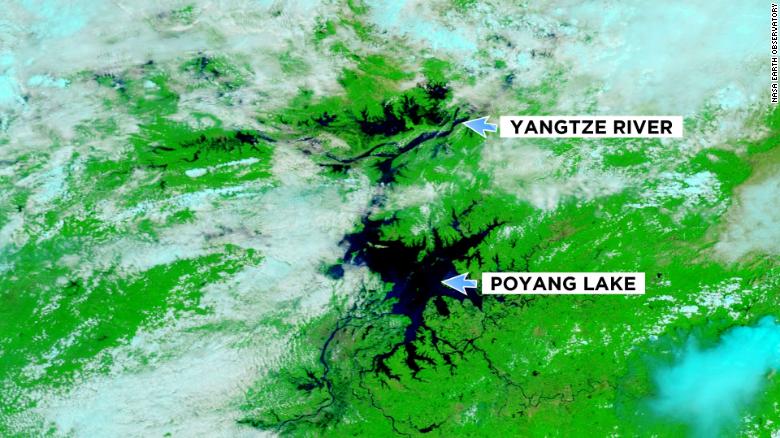“The crops have completely failed,” Bao told CNN Business in an interview over the social media app WeChat, adding that his family has already lost roughly 200,000 yuan ($28,000) worth of produce. “The rice was nearly ripened and ready to harvest before the flooding. But now everything is gone.”
Surging floodwater burst the banks of Poyang Lake in Jiangxi province last month, destroying thousands of acres of farmland in what’s known as the “land of fish and rice.” The broader Yangtze River basin — which includes Poyang Lake and stretches more than 3,900 miles from Shanghai in the east to the Tibetan border in the west — accounts for 70% of the country’s rice production.
For farmers like Bao and his father, the damage has been devastating. Not only did the rainfall ruin crops they were about to collect, but the scale of the flooding has made it impossible to salvage anything from this year.
“The land is still under water,” Bao said. “That means we are not going to have any harvest for the entire year.”
The flooding that walloped Bao’s farm and 13 million more acres of cropland — about the size of West Virginia — is the worst that that China has experienced in years. China’s Ministry of Emergency Management pegs the direct economic cost of the disaster at $21 billion in destroyed farmland, roads and other property. Some 55 million people, including farmers like Bao, have been affected.
The disaster is bad news for the world’s second-largest economy, which is already in a fragile state because of the coronavirus pandemic. Beijing has so far been able to secure food supplies by importing vast amounts of produce from other countries, and by releasing tens of millions of tons from strategic reserves.
But analysts warn that such measures can only be useful for so long. Tense relationships between China and much of the Western world, and the coronavirus pandemic, may make importing a lot of food trickier in the future. The flooding in China, meanwhile, could soon get worse: Heavy rainfall is expected through much of this month, and Chinese officials have warned that the flooding could creep further north, threatening the country’s wheat and corn harvests.
“The flooding is already among the worst since 1998, and could worsen in coming weeks,” analysts from Nomura said in a note late last month.
Food security
It’s not entirely clear how much of China’s food supply may be at risk, since the government hasn’t released specifics about the current state of production.
If the flooding is contained by the end of August, agricultural GDP growth could fall by nearly a percentage point in the July-September quarter, according to analysts at Nomura — equivalent to more than $1.7 billion in lost agricultural output. That amount is based on losses recorded in mid-July in seven southern provinces that were hit particularly hard.
Analysts at the Chinese brokerage firm Shenwan Hongyuan, meanwhile, recently estimated that China could lose 11.2 million tons worth of food compared to last year, given how much cropland was damaged by mid July. That would be equivalent to 5% of the rice that China produces.
The damage might be even worse, though. Nomura’s analysis was based on data about flooded crop fields that the Chinese government released in July. Since then, the amount of cropland that has been damaged has roughly doubled, according to China’s Ministry of Emergency Response. Damage estimates released by analysts also don’t include the potential loss of wheat, corn or other crops, which could be threatened should the flooding spread.
Already, analysts point out that corn costs have been surging. The price of corn in China was 20% higher last month compared to a year ago, according to Chinese data provider SCI — the highest level in five years.
“I came here mainly to check out the crops,” Xi said in a video posted by state broadcaster CCTV. “There are quite a few disasters this year. I’m concerned about how crops are growing here in the northeast.”
Xi has good reason to visit the area. Northeastern China produces more than 40% of the country’s soybeans and a third of its corn — both vital to the food supply chain, since they are fed to livestock and poultry. China uses more soybeans than any other country in the world, and it’s only behind the United States in corn consumption. And while the region has so far been spared major flooding, that could change should conditions worsen in the coming weeks.
China’s response keeps rice price stable
Beijing has responded to the crisis with attempts to stabilize food prices and boost supply — including by tapping into strategic reserves of food.
Tens of millions of tons of rice, corn and soybeans have been released into the market in recent months by the China Grain Reserves Corp and the National Grain Trade Center, the two agencies that manage and sell state reserves of grain.
So far this year, the agencies have released more than 60 million tons of rice, about 50 million tons of corn, and over 760,000 tons of soybeans, already surpassing the volumes released during the whole of 2019.
Thanks to the release of those reserves, prices for rice have remained stable. Last week the average price of a ton of rice nationwide was 4,036 yuan ($580) per ton, roughly what it was a month ago, according to data from SCI.
China is also increasing imports — especially from the United States. Beijing committed to buying billions of dollars worth of American goods as part of a truce in the trade war agreed in January.
In the first six months of the year, China imported nearly 61 million tons of grain, up 21% from a year earlier, according to the most recently available Chinese customs data. Corn imports jumped 18% from a year ago, while purchases of soybeans and wheat also increased. The United States, Brazil, Ukraine and France were among the biggest exporters.
Some analysts, though, caution that China shouldn’t rely too much on overseas imports.
The trade relationship between Beijing and Washington, for example, could create uncertainty for China’s food supply chain should US authorities cut off or heavily tax those imports, according to analysts from Chinese research firm Tianfeng Securities. The United States exported more than 9 million tons of soybeans, roughly 100,000 tons of wheat, and nearly 65,000 tons of corn to China in the first half of 2020, making it a top trading partner, according to the most recently available Chinese customs data.
The Covid-19 pandemic has also caused some countries to suspend food exports, the Tianfeng Securities analysts added in a recent research note, creating more risks for food security in China.
The analysts suggested a few options for China to increase food production, including to loosen restrictions on the production of genetically modified crops. But they also acknowledged that at least in the short term, the country may have to import as much as it can before its trade relationships can deteriorate.
“China needs to put something away for a rainy day,” they said.
As for farmers like Bao, China has set aside some money for flood relief. As of mid-July, some 1.8 billion yuan ($258 million) had been allocated to help relocate people affected by the floods and rebuild ruined houses, among other measures, according to China’s Finance Ministry. The local government in Jiangxi province, where Bao lives, has also allocated 280 million yuan ($40 million) for flood relief.
But that’s a drop in the bucket compared to the $21 billion worth of economic damage the flooding has already inflicted.
“Yes, the government has subsidies, but it can’t really help much,” said Bao. His father has already left home to look for other jobs now that there’s no hope for another crop season this year. “Spreading it out for each person, there is not much left.”




Average Rating